Legal Analysis of Construction Contracts: Problem Question & Essay
VerifiedAdded on 2023/06/14
|20
|5187
|317
Essay
AI Summary
This essay provides a legal analysis of construction contracts, focusing on dispute resolution and potential liabilities. It examines a case involving Corporate Raider Associates LLP and Sitting-Duck Construction Targets Limited, highlighting issues arising from a failed contract with engineering faults. The essay discusses the applicability of the 1996 Housing Grants, Construction and Regeneration Act, novation agreements, and the roles of various parties, including ScottFree Consulting Partnership. It explores alternative dispute resolution (ADR) methods like mediation and conciliation, referencing relevant cases and legal provisions. The essay also emphasizes the importance of clear contractual documentation, addressing potential gaps and necessary amendments to prevent future disputes. It suggests strengthening the legal system, especially regarding contract provisions, and incorporating international standards like JCT and FIDIC forms. Ultimately, the essay advocates for a comprehensive approach to construction contracts, ensuring fairness, clarity, and effective dispute resolution mechanisms.

1
Construction Contracts
Word Count: 3859
Construction Contracts
Word Count: 3859
Paraphrase This Document
Need a fresh take? Get an instant paraphrase of this document with our AI Paraphraser
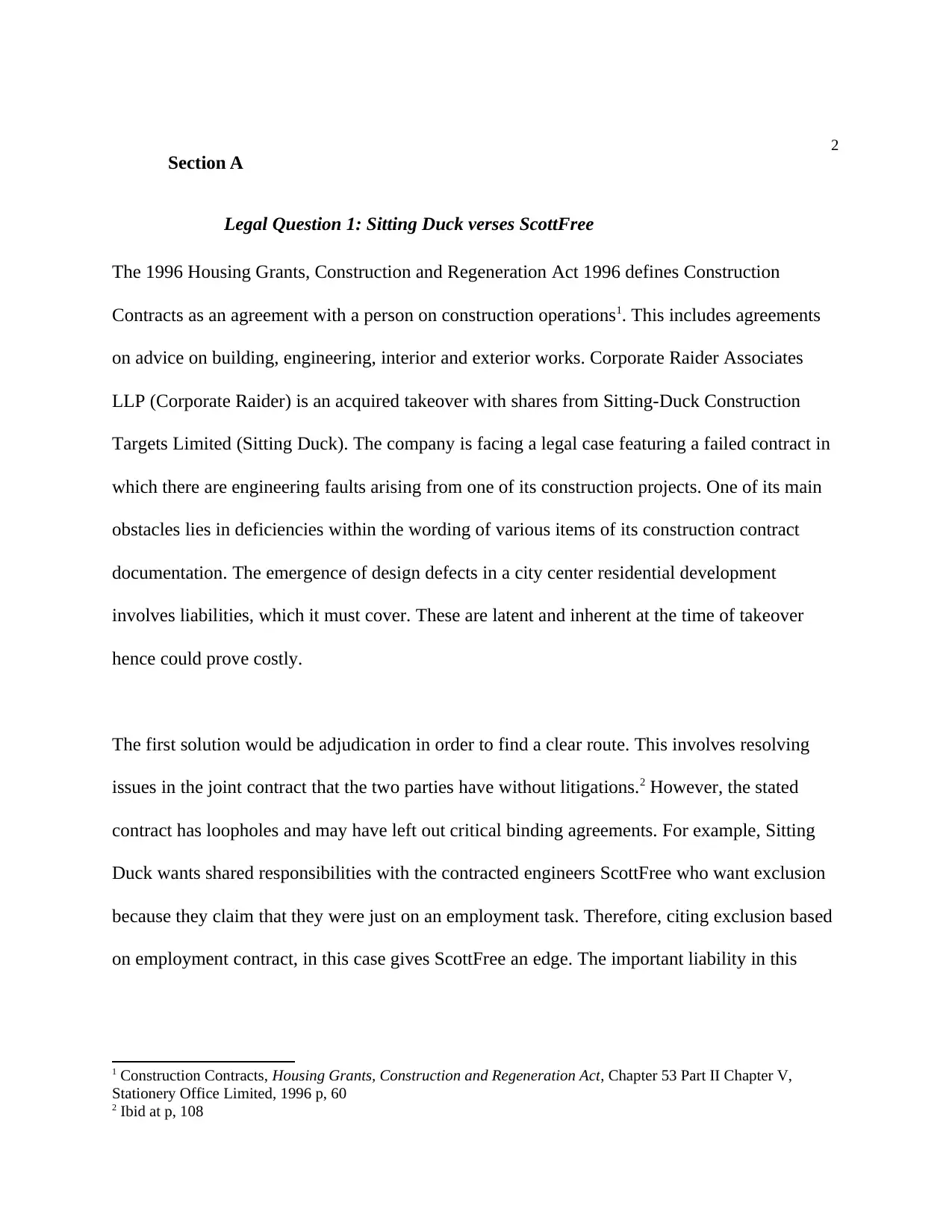
2
Section A
Legal Question 1: Sitting Duck verses ScottFree
The 1996 Housing Grants, Construction and Regeneration Act 1996 defines Construction
Contracts as an agreement with a person on construction operations1. This includes agreements
on advice on building, engineering, interior and exterior works. Corporate Raider Associates
LLP (Corporate Raider) is an acquired takeover with shares from Sitting-Duck Construction
Targets Limited (Sitting Duck). The company is facing a legal case featuring a failed contract in
which there are engineering faults arising from one of its construction projects. One of its main
obstacles lies in deficiencies within the wording of various items of its construction contract
documentation. The emergence of design defects in a city center residential development
involves liabilities, which it must cover. These are latent and inherent at the time of takeover
hence could prove costly.
The first solution would be adjudication in order to find a clear route. This involves resolving
issues in the joint contract that the two parties have without litigations.2 However, the stated
contract has loopholes and may have left out critical binding agreements. For example, Sitting
Duck wants shared responsibilities with the contracted engineers ScottFree who want exclusion
because they claim that they were just on an employment task. Therefore, citing exclusion based
on employment contract, in this case gives ScottFree an edge. The important liability in this
1 Construction Contracts, Housing Grants, Construction and Regeneration Act, Chapter 53 Part II Chapter V,
Stationery Office Limited, 1996 p, 60
2 Ibid at p, 108
Section A
Legal Question 1: Sitting Duck verses ScottFree
The 1996 Housing Grants, Construction and Regeneration Act 1996 defines Construction
Contracts as an agreement with a person on construction operations1. This includes agreements
on advice on building, engineering, interior and exterior works. Corporate Raider Associates
LLP (Corporate Raider) is an acquired takeover with shares from Sitting-Duck Construction
Targets Limited (Sitting Duck). The company is facing a legal case featuring a failed contract in
which there are engineering faults arising from one of its construction projects. One of its main
obstacles lies in deficiencies within the wording of various items of its construction contract
documentation. The emergence of design defects in a city center residential development
involves liabilities, which it must cover. These are latent and inherent at the time of takeover
hence could prove costly.
The first solution would be adjudication in order to find a clear route. This involves resolving
issues in the joint contract that the two parties have without litigations.2 However, the stated
contract has loopholes and may have left out critical binding agreements. For example, Sitting
Duck wants shared responsibilities with the contracted engineers ScottFree who want exclusion
because they claim that they were just on an employment task. Therefore, citing exclusion based
on employment contract, in this case gives ScottFree an edge. The important liability in this
1 Construction Contracts, Housing Grants, Construction and Regeneration Act, Chapter 53 Part II Chapter V,
Stationery Office Limited, 1996 p, 60
2 Ibid at p, 108
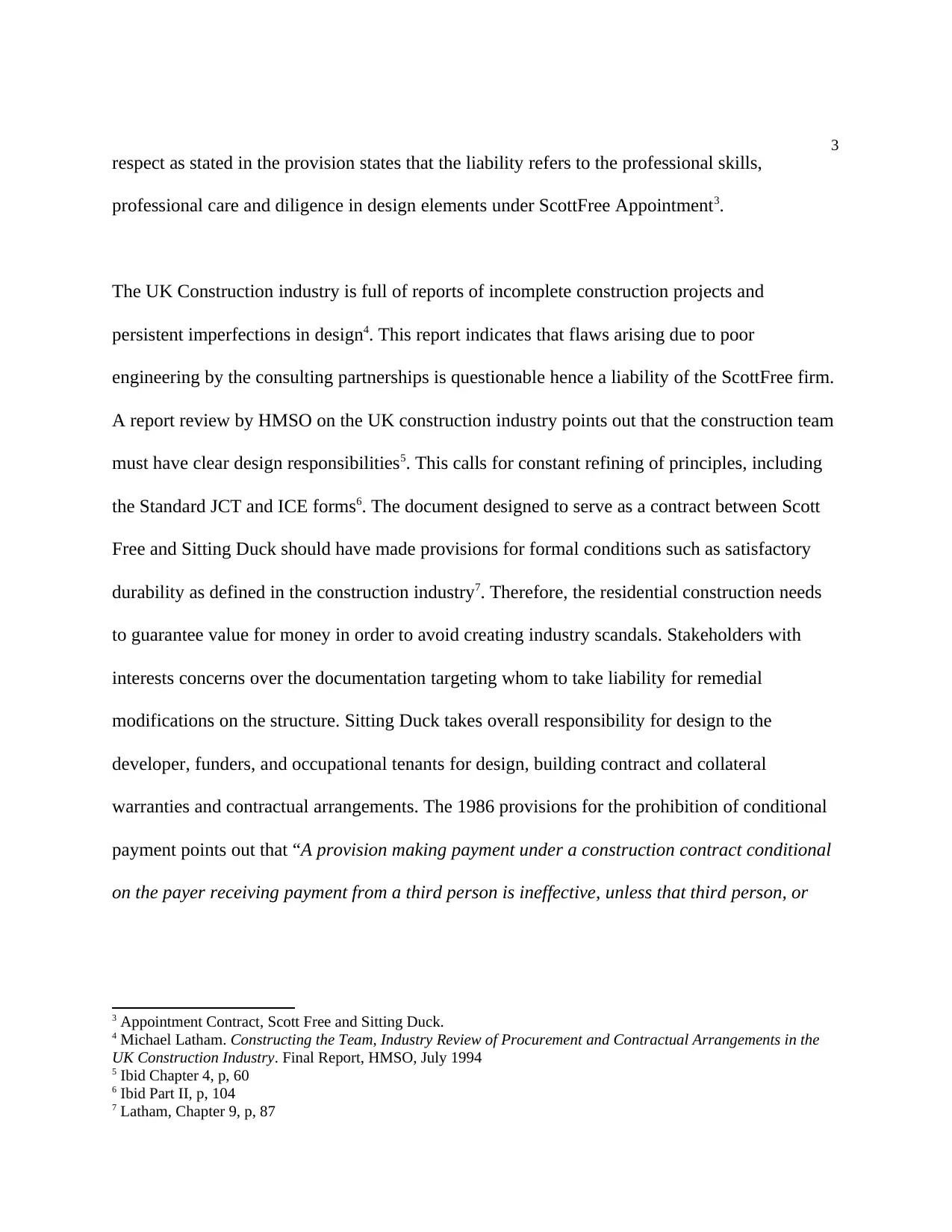
3
respect as stated in the provision states that the liability refers to the professional skills,
professional care and diligence in design elements under ScottFree Appointment3.
The UK Construction industry is full of reports of incomplete construction projects and
persistent imperfections in design4. This report indicates that flaws arising due to poor
engineering by the consulting partnerships is questionable hence a liability of the ScottFree firm.
A report review by HMSO on the UK construction industry points out that the construction team
must have clear design responsibilities5. This calls for constant refining of principles, including
the Standard JCT and ICE forms6. The document designed to serve as a contract between Scott
Free and Sitting Duck should have made provisions for formal conditions such as satisfactory
durability as defined in the construction industry7. Therefore, the residential construction needs
to guarantee value for money in order to avoid creating industry scandals. Stakeholders with
interests concerns over the documentation targeting whom to take liability for remedial
modifications on the structure. Sitting Duck takes overall responsibility for design to the
developer, funders, and occupational tenants for design, building contract and collateral
warranties and contractual arrangements. The 1986 provisions for the prohibition of conditional
payment points out that “A provision making payment under a construction contract conditional
on the payer receiving payment from a third person is ineffective, unless that third person, or
3 Appointment Contract, Scott Free and Sitting Duck.
4 Michael Latham. Constructing the Team, Industry Review of Procurement and Contractual Arrangements in the
UK Construction Industry. Final Report, HMSO, July 1994
5 Ibid Chapter 4, p, 60
6 Ibid Part II, p, 104
7 Latham, Chapter 9, p, 87
respect as stated in the provision states that the liability refers to the professional skills,
professional care and diligence in design elements under ScottFree Appointment3.
The UK Construction industry is full of reports of incomplete construction projects and
persistent imperfections in design4. This report indicates that flaws arising due to poor
engineering by the consulting partnerships is questionable hence a liability of the ScottFree firm.
A report review by HMSO on the UK construction industry points out that the construction team
must have clear design responsibilities5. This calls for constant refining of principles, including
the Standard JCT and ICE forms6. The document designed to serve as a contract between Scott
Free and Sitting Duck should have made provisions for formal conditions such as satisfactory
durability as defined in the construction industry7. Therefore, the residential construction needs
to guarantee value for money in order to avoid creating industry scandals. Stakeholders with
interests concerns over the documentation targeting whom to take liability for remedial
modifications on the structure. Sitting Duck takes overall responsibility for design to the
developer, funders, and occupational tenants for design, building contract and collateral
warranties and contractual arrangements. The 1986 provisions for the prohibition of conditional
payment points out that “A provision making payment under a construction contract conditional
on the payer receiving payment from a third person is ineffective, unless that third person, or
3 Appointment Contract, Scott Free and Sitting Duck.
4 Michael Latham. Constructing the Team, Industry Review of Procurement and Contractual Arrangements in the
UK Construction Industry. Final Report, HMSO, July 1994
5 Ibid Chapter 4, p, 60
6 Ibid Part II, p, 104
7 Latham, Chapter 9, p, 87
⊘ This is a preview!⊘
Do you want full access?
Subscribe today to unlock all pages.

Trusted by 1+ million students worldwide
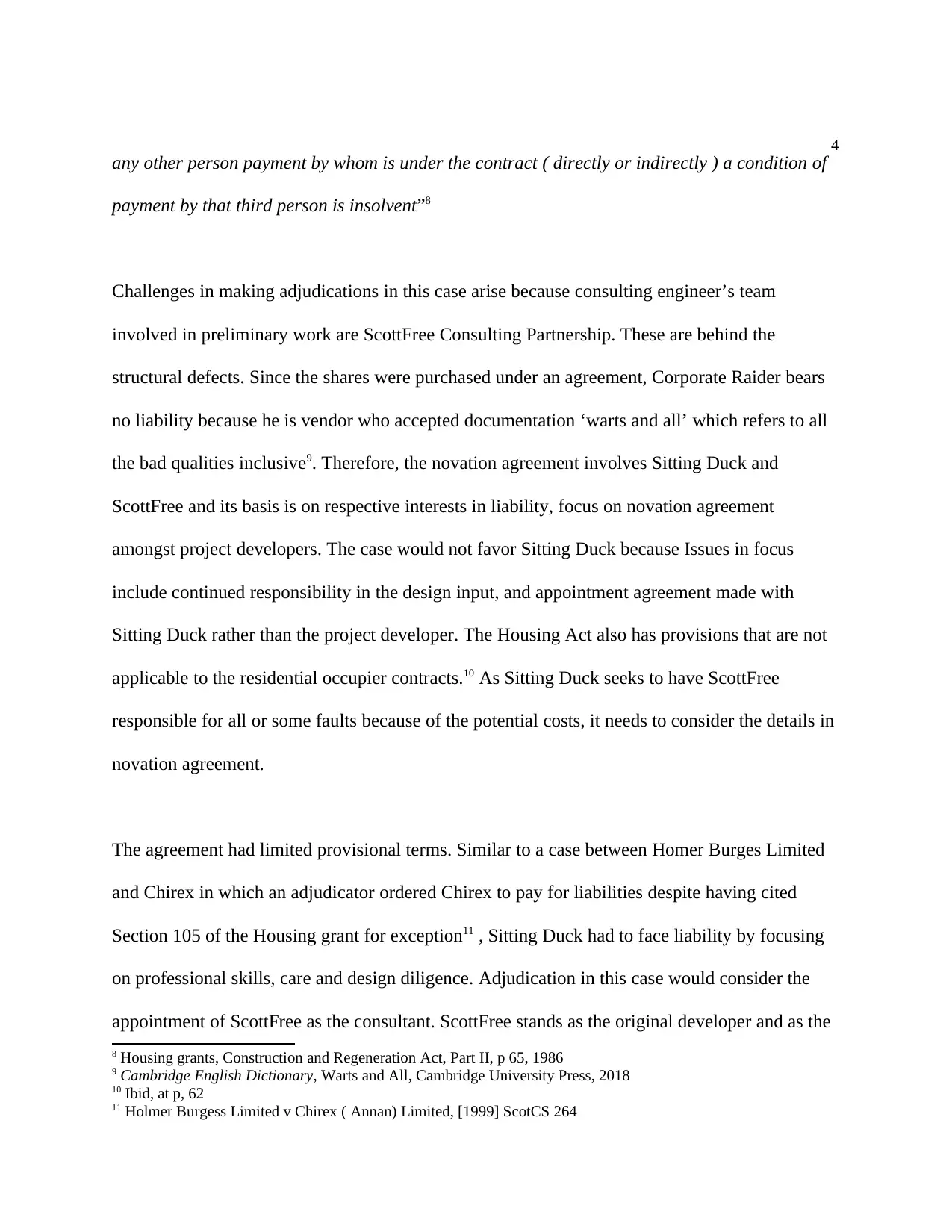
4
any other person payment by whom is under the contract ( directly or indirectly ) a condition of
payment by that third person is insolvent”8
Challenges in making adjudications in this case arise because consulting engineer’s team
involved in preliminary work are ScottFree Consulting Partnership. These are behind the
structural defects. Since the shares were purchased under an agreement, Corporate Raider bears
no liability because he is vendor who accepted documentation ‘warts and all’ which refers to all
the bad qualities inclusive9. Therefore, the novation agreement involves Sitting Duck and
ScottFree and its basis is on respective interests in liability, focus on novation agreement
amongst project developers. The case would not favor Sitting Duck because Issues in focus
include continued responsibility in the design input, and appointment agreement made with
Sitting Duck rather than the project developer. The Housing Act also has provisions that are not
applicable to the residential occupier contracts.10 As Sitting Duck seeks to have ScottFree
responsible for all or some faults because of the potential costs, it needs to consider the details in
novation agreement.
The agreement had limited provisional terms. Similar to a case between Homer Burges Limited
and Chirex in which an adjudicator ordered Chirex to pay for liabilities despite having cited
Section 105 of the Housing grant for exception11 , Sitting Duck had to face liability by focusing
on professional skills, care and design diligence. Adjudication in this case would consider the
appointment of ScottFree as the consultant. ScottFree stands as the original developer and as the
8 Housing grants, Construction and Regeneration Act, Part II, p 65, 1986
9 Cambridge English Dictionary, Warts and All, Cambridge University Press, 2018
10 Ibid, at p, 62
11 Holmer Burgess Limited v Chirex ( Annan) Limited, [1999] ScotCS 264
any other person payment by whom is under the contract ( directly or indirectly ) a condition of
payment by that third person is insolvent”8
Challenges in making adjudications in this case arise because consulting engineer’s team
involved in preliminary work are ScottFree Consulting Partnership. These are behind the
structural defects. Since the shares were purchased under an agreement, Corporate Raider bears
no liability because he is vendor who accepted documentation ‘warts and all’ which refers to all
the bad qualities inclusive9. Therefore, the novation agreement involves Sitting Duck and
ScottFree and its basis is on respective interests in liability, focus on novation agreement
amongst project developers. The case would not favor Sitting Duck because Issues in focus
include continued responsibility in the design input, and appointment agreement made with
Sitting Duck rather than the project developer. The Housing Act also has provisions that are not
applicable to the residential occupier contracts.10 As Sitting Duck seeks to have ScottFree
responsible for all or some faults because of the potential costs, it needs to consider the details in
novation agreement.
The agreement had limited provisional terms. Similar to a case between Homer Burges Limited
and Chirex in which an adjudicator ordered Chirex to pay for liabilities despite having cited
Section 105 of the Housing grant for exception11 , Sitting Duck had to face liability by focusing
on professional skills, care and design diligence. Adjudication in this case would consider the
appointment of ScottFree as the consultant. ScottFree stands as the original developer and as the
8 Housing grants, Construction and Regeneration Act, Part II, p 65, 1986
9 Cambridge English Dictionary, Warts and All, Cambridge University Press, 2018
10 Ibid, at p, 62
11 Holmer Burgess Limited v Chirex ( Annan) Limited, [1999] ScotCS 264
Paraphrase This Document
Need a fresh take? Get an instant paraphrase of this document with our AI Paraphraser
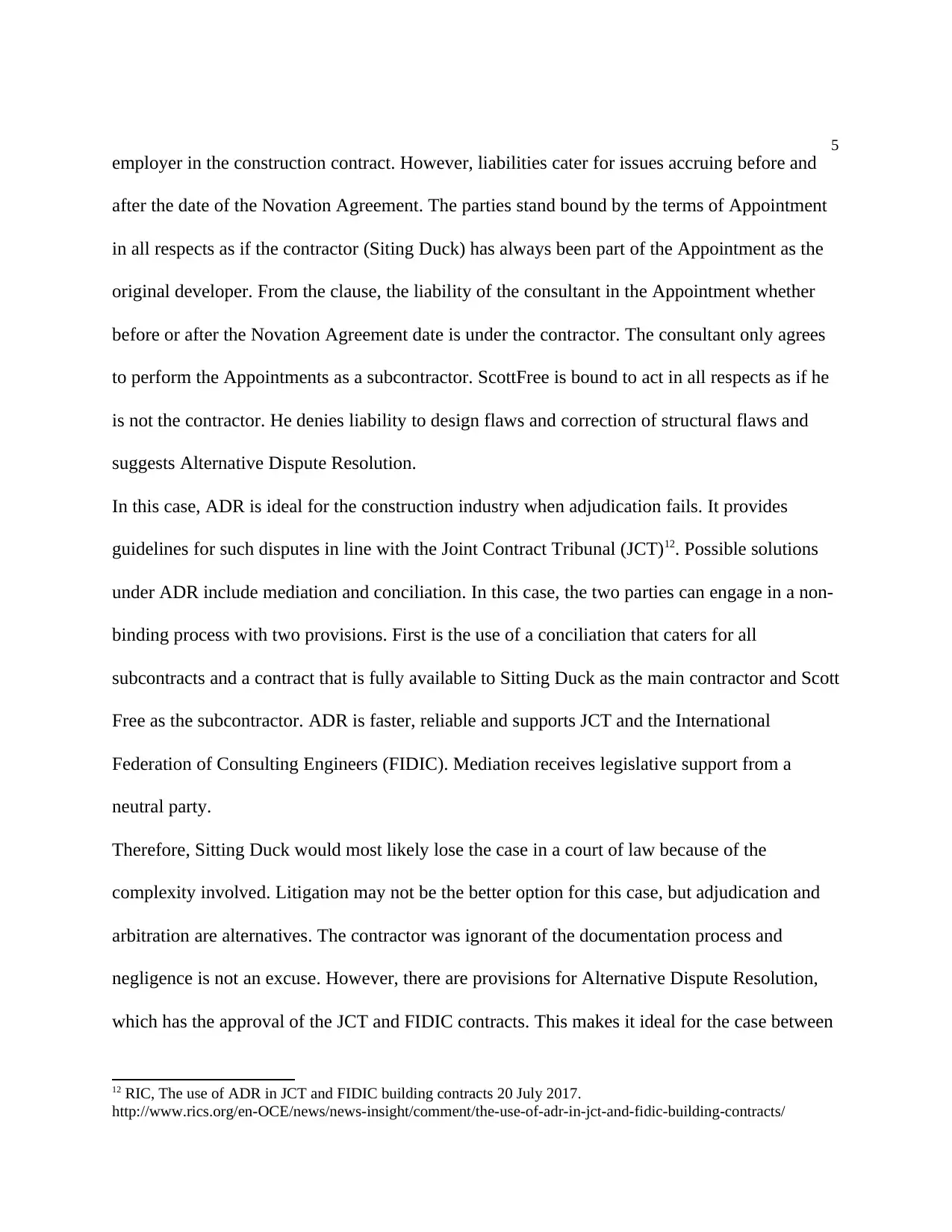
5
employer in the construction contract. However, liabilities cater for issues accruing before and
after the date of the Novation Agreement. The parties stand bound by the terms of Appointment
in all respects as if the contractor (Siting Duck) has always been part of the Appointment as the
original developer. From the clause, the liability of the consultant in the Appointment whether
before or after the Novation Agreement date is under the contractor. The consultant only agrees
to perform the Appointments as a subcontractor. ScottFree is bound to act in all respects as if he
is not the contractor. He denies liability to design flaws and correction of structural flaws and
suggests Alternative Dispute Resolution.
In this case, ADR is ideal for the construction industry when adjudication fails. It provides
guidelines for such disputes in line with the Joint Contract Tribunal (JCT)12. Possible solutions
under ADR include mediation and conciliation. In this case, the two parties can engage in a non-
binding process with two provisions. First is the use of a conciliation that caters for all
subcontracts and a contract that is fully available to Sitting Duck as the main contractor and Scott
Free as the subcontractor. ADR is faster, reliable and supports JCT and the International
Federation of Consulting Engineers (FIDIC). Mediation receives legislative support from a
neutral party.
Therefore, Sitting Duck would most likely lose the case in a court of law because of the
complexity involved. Litigation may not be the better option for this case, but adjudication and
arbitration are alternatives. The contractor was ignorant of the documentation process and
negligence is not an excuse. However, there are provisions for Alternative Dispute Resolution,
which has the approval of the JCT and FIDIC contracts. This makes it ideal for the case between
12 RIC, The use of ADR in JCT and FIDIC building contracts 20 July 2017.
http://www.rics.org/en-OCE/news/news-insight/comment/the-use-of-adr-in-jct-and-fidic-building-contracts/
employer in the construction contract. However, liabilities cater for issues accruing before and
after the date of the Novation Agreement. The parties stand bound by the terms of Appointment
in all respects as if the contractor (Siting Duck) has always been part of the Appointment as the
original developer. From the clause, the liability of the consultant in the Appointment whether
before or after the Novation Agreement date is under the contractor. The consultant only agrees
to perform the Appointments as a subcontractor. ScottFree is bound to act in all respects as if he
is not the contractor. He denies liability to design flaws and correction of structural flaws and
suggests Alternative Dispute Resolution.
In this case, ADR is ideal for the construction industry when adjudication fails. It provides
guidelines for such disputes in line with the Joint Contract Tribunal (JCT)12. Possible solutions
under ADR include mediation and conciliation. In this case, the two parties can engage in a non-
binding process with two provisions. First is the use of a conciliation that caters for all
subcontracts and a contract that is fully available to Sitting Duck as the main contractor and Scott
Free as the subcontractor. ADR is faster, reliable and supports JCT and the International
Federation of Consulting Engineers (FIDIC). Mediation receives legislative support from a
neutral party.
Therefore, Sitting Duck would most likely lose the case in a court of law because of the
complexity involved. Litigation may not be the better option for this case, but adjudication and
arbitration are alternatives. The contractor was ignorant of the documentation process and
negligence is not an excuse. However, there are provisions for Alternative Dispute Resolution,
which has the approval of the JCT and FIDIC contracts. This makes it ideal for the case between
12 RIC, The use of ADR in JCT and FIDIC building contracts 20 July 2017.
http://www.rics.org/en-OCE/news/news-insight/comment/the-use-of-adr-in-jct-and-fidic-building-contracts/
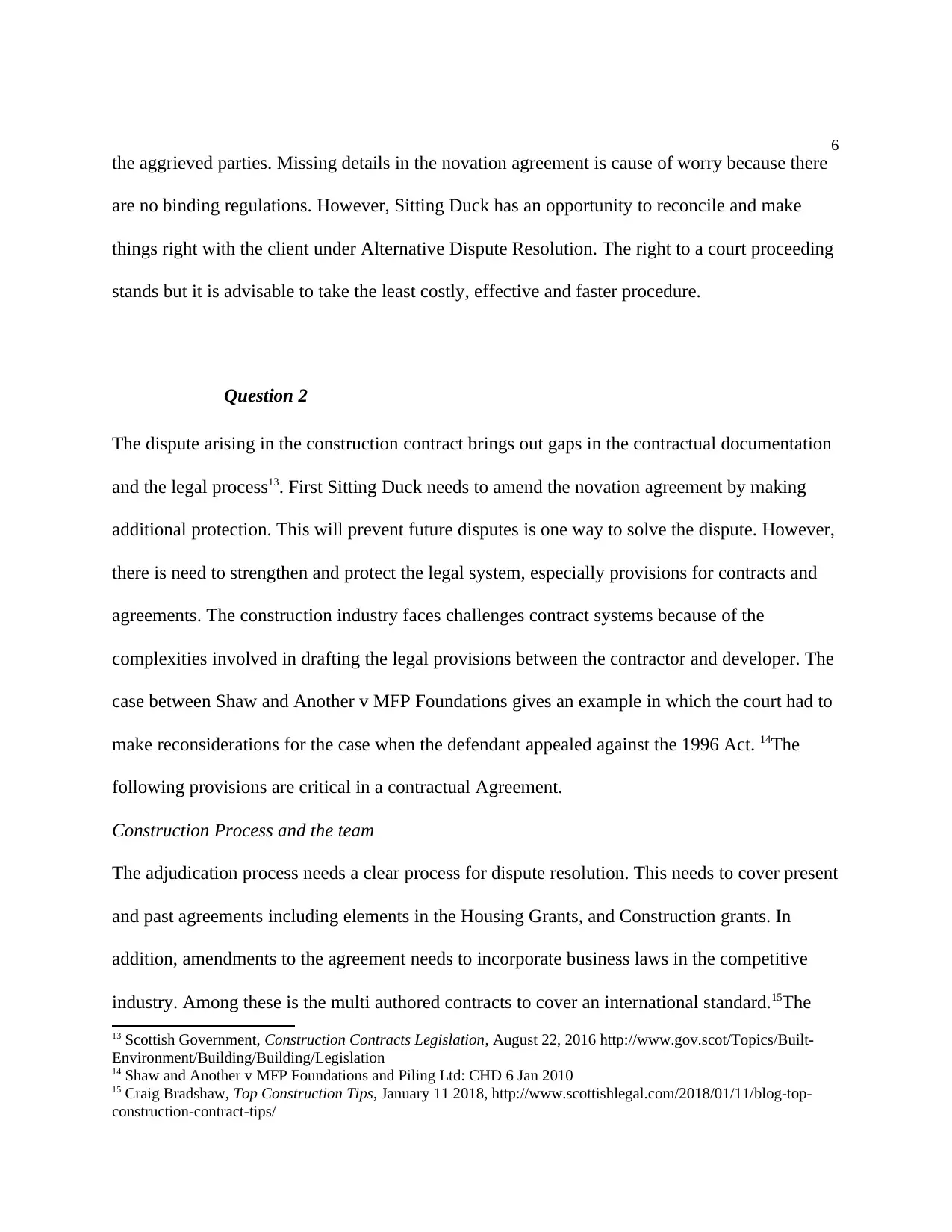
6
the aggrieved parties. Missing details in the novation agreement is cause of worry because there
are no binding regulations. However, Sitting Duck has an opportunity to reconcile and make
things right with the client under Alternative Dispute Resolution. The right to a court proceeding
stands but it is advisable to take the least costly, effective and faster procedure.
Question 2
The dispute arising in the construction contract brings out gaps in the contractual documentation
and the legal process13. First Sitting Duck needs to amend the novation agreement by making
additional protection. This will prevent future disputes is one way to solve the dispute. However,
there is need to strengthen and protect the legal system, especially provisions for contracts and
agreements. The construction industry faces challenges contract systems because of the
complexities involved in drafting the legal provisions between the contractor and developer. The
case between Shaw and Another v MFP Foundations gives an example in which the court had to
make reconsiderations for the case when the defendant appealed against the 1996 Act. 14The
following provisions are critical in a contractual Agreement.
Construction Process and the team
The adjudication process needs a clear process for dispute resolution. This needs to cover present
and past agreements including elements in the Housing Grants, and Construction grants. In
addition, amendments to the agreement needs to incorporate business laws in the competitive
industry. Among these is the multi authored contracts to cover an international standard.15The
13 Scottish Government, Construction Contracts Legislation, August 22, 2016 http://www.gov.scot/Topics/Built-
Environment/Building/Building/Legislation
14 Shaw and Another v MFP Foundations and Piling Ltd: CHD 6 Jan 2010
15 Craig Bradshaw, Top Construction Tips, January 11 2018, http://www.scottishlegal.com/2018/01/11/blog-top-
construction-contract-tips/
the aggrieved parties. Missing details in the novation agreement is cause of worry because there
are no binding regulations. However, Sitting Duck has an opportunity to reconcile and make
things right with the client under Alternative Dispute Resolution. The right to a court proceeding
stands but it is advisable to take the least costly, effective and faster procedure.
Question 2
The dispute arising in the construction contract brings out gaps in the contractual documentation
and the legal process13. First Sitting Duck needs to amend the novation agreement by making
additional protection. This will prevent future disputes is one way to solve the dispute. However,
there is need to strengthen and protect the legal system, especially provisions for contracts and
agreements. The construction industry faces challenges contract systems because of the
complexities involved in drafting the legal provisions between the contractor and developer. The
case between Shaw and Another v MFP Foundations gives an example in which the court had to
make reconsiderations for the case when the defendant appealed against the 1996 Act. 14The
following provisions are critical in a contractual Agreement.
Construction Process and the team
The adjudication process needs a clear process for dispute resolution. This needs to cover present
and past agreements including elements in the Housing Grants, and Construction grants. In
addition, amendments to the agreement needs to incorporate business laws in the competitive
industry. Among these is the multi authored contracts to cover an international standard.15The
13 Scottish Government, Construction Contracts Legislation, August 22, 2016 http://www.gov.scot/Topics/Built-
Environment/Building/Building/Legislation
14 Shaw and Another v MFP Foundations and Piling Ltd: CHD 6 Jan 2010
15 Craig Bradshaw, Top Construction Tips, January 11 2018, http://www.scottishlegal.com/2018/01/11/blog-top-
construction-contract-tips/
⊘ This is a preview!⊘
Do you want full access?
Subscribe today to unlock all pages.

Trusted by 1+ million students worldwide
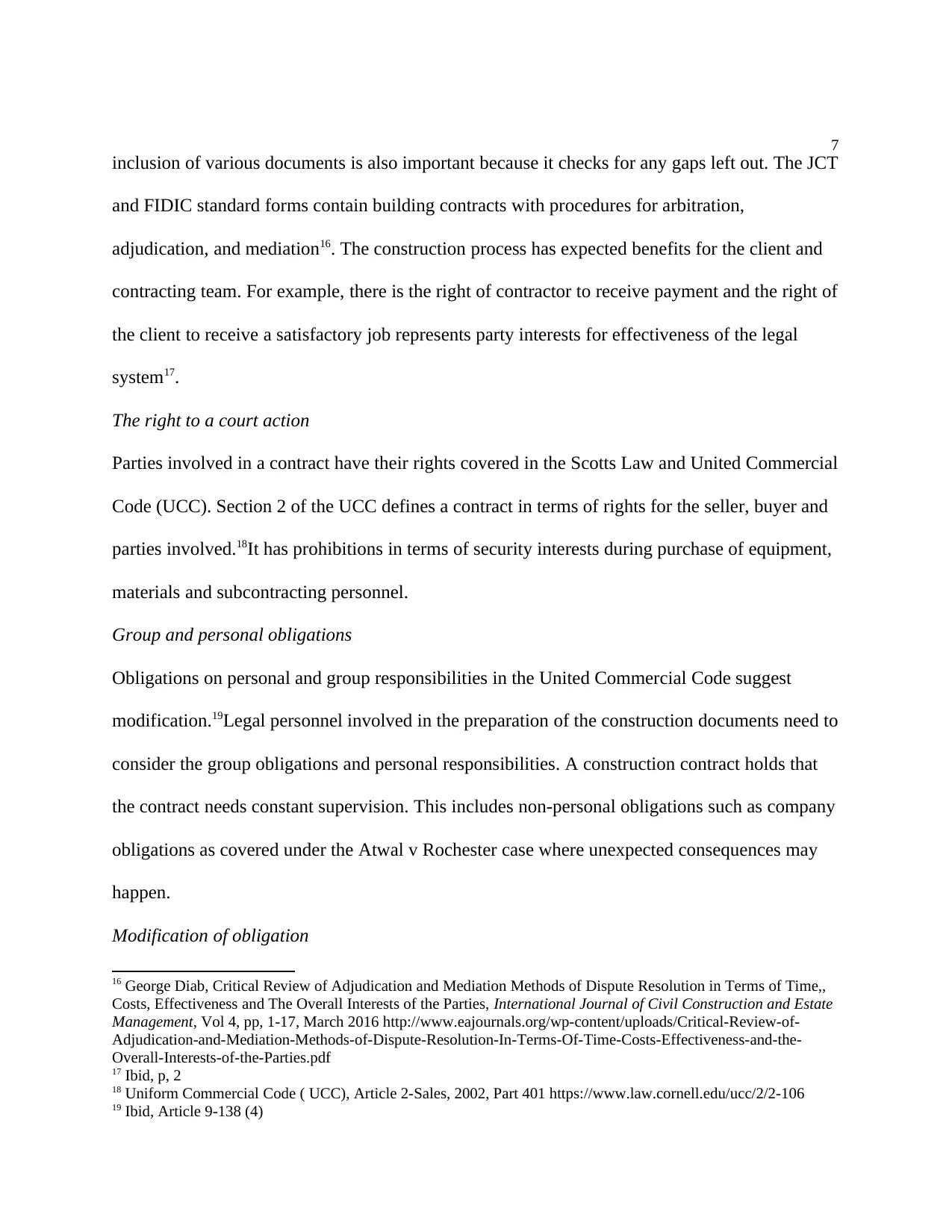
7
inclusion of various documents is also important because it checks for any gaps left out. The JCT
and FIDIC standard forms contain building contracts with procedures for arbitration,
adjudication, and mediation16. The construction process has expected benefits for the client and
contracting team. For example, there is the right of contractor to receive payment and the right of
the client to receive a satisfactory job represents party interests for effectiveness of the legal
system17.
The right to a court action
Parties involved in a contract have their rights covered in the Scotts Law and United Commercial
Code (UCC). Section 2 of the UCC defines a contract in terms of rights for the seller, buyer and
parties involved.18It has prohibitions in terms of security interests during purchase of equipment,
materials and subcontracting personnel.
Group and personal obligations
Obligations on personal and group responsibilities in the United Commercial Code suggest
modification.19Legal personnel involved in the preparation of the construction documents need to
consider the group obligations and personal responsibilities. A construction contract holds that
the contract needs constant supervision. This includes non-personal obligations such as company
obligations as covered under the Atwal v Rochester case where unexpected consequences may
happen.
Modification of obligation
16 George Diab, Critical Review of Adjudication and Mediation Methods of Dispute Resolution in Terms of Time,,
Costs, Effectiveness and The Overall Interests of the Parties, International Journal of Civil Construction and Estate
Management, Vol 4, pp, 1-17, March 2016 http://www.eajournals.org/wp-content/uploads/Critical-Review-of-
Adjudication-and-Mediation-Methods-of-Dispute-Resolution-In-Terms-Of-Time-Costs-Effectiveness-and-the-
Overall-Interests-of-the-Parties.pdf
17 Ibid, p, 2
18 Uniform Commercial Code ( UCC), Article 2-Sales, 2002, Part 401 https://www.law.cornell.edu/ucc/2/2-106
19 Ibid, Article 9-138 (4)
inclusion of various documents is also important because it checks for any gaps left out. The JCT
and FIDIC standard forms contain building contracts with procedures for arbitration,
adjudication, and mediation16. The construction process has expected benefits for the client and
contracting team. For example, there is the right of contractor to receive payment and the right of
the client to receive a satisfactory job represents party interests for effectiveness of the legal
system17.
The right to a court action
Parties involved in a contract have their rights covered in the Scotts Law and United Commercial
Code (UCC). Section 2 of the UCC defines a contract in terms of rights for the seller, buyer and
parties involved.18It has prohibitions in terms of security interests during purchase of equipment,
materials and subcontracting personnel.
Group and personal obligations
Obligations on personal and group responsibilities in the United Commercial Code suggest
modification.19Legal personnel involved in the preparation of the construction documents need to
consider the group obligations and personal responsibilities. A construction contract holds that
the contract needs constant supervision. This includes non-personal obligations such as company
obligations as covered under the Atwal v Rochester case where unexpected consequences may
happen.
Modification of obligation
16 George Diab, Critical Review of Adjudication and Mediation Methods of Dispute Resolution in Terms of Time,,
Costs, Effectiveness and The Overall Interests of the Parties, International Journal of Civil Construction and Estate
Management, Vol 4, pp, 1-17, March 2016 http://www.eajournals.org/wp-content/uploads/Critical-Review-of-
Adjudication-and-Mediation-Methods-of-Dispute-Resolution-In-Terms-Of-Time-Costs-Effectiveness-and-the-
Overall-Interests-of-the-Parties.pdf
17 Ibid, p, 2
18 Uniform Commercial Code ( UCC), Article 2-Sales, 2002, Part 401 https://www.law.cornell.edu/ucc/2/2-106
19 Ibid, Article 9-138 (4)
Paraphrase This Document
Need a fresh take? Get an instant paraphrase of this document with our AI Paraphraser
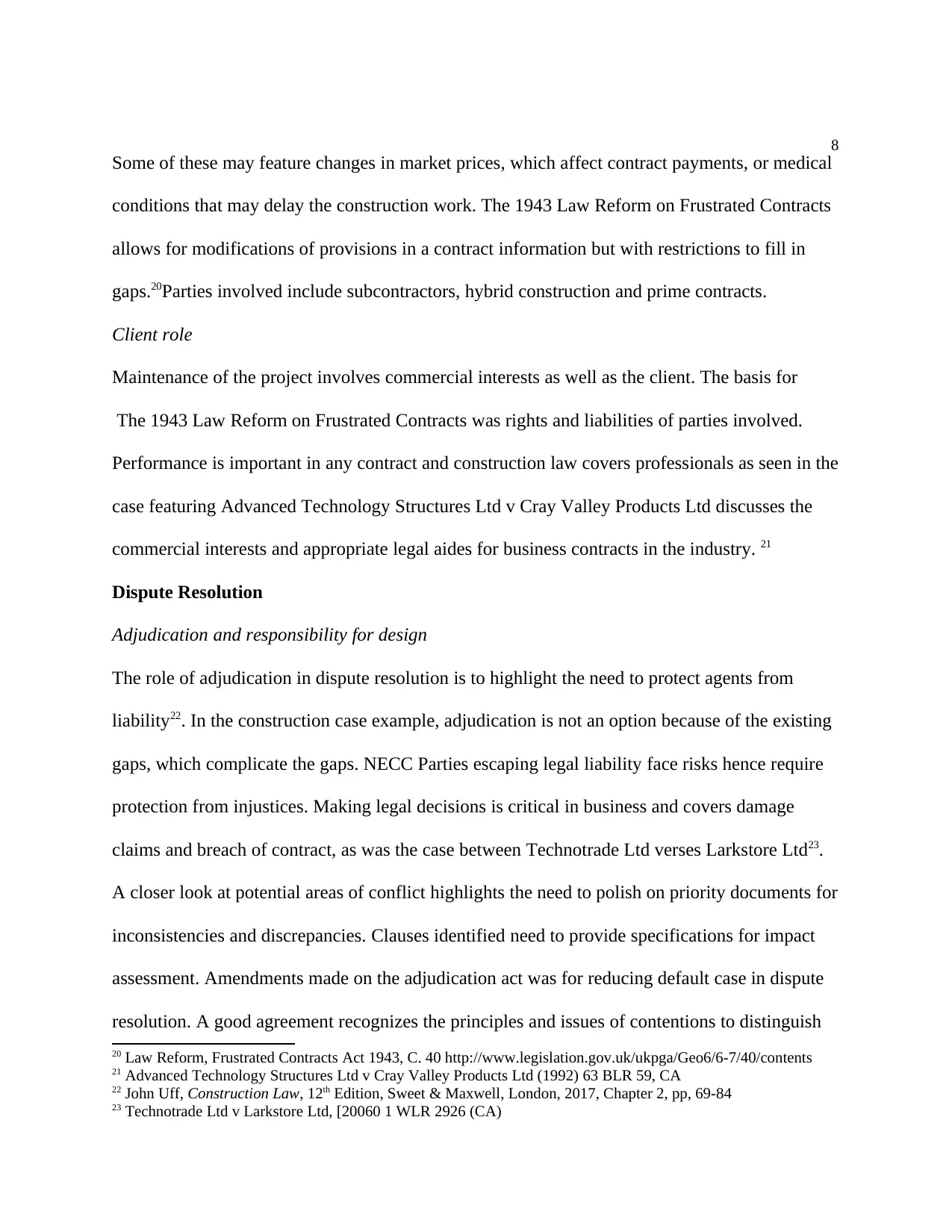
8
Some of these may feature changes in market prices, which affect contract payments, or medical
conditions that may delay the construction work. The 1943 Law Reform on Frustrated Contracts
allows for modifications of provisions in a contract information but with restrictions to fill in
gaps.20Parties involved include subcontractors, hybrid construction and prime contracts.
Client role
Maintenance of the project involves commercial interests as well as the client. The basis for
The 1943 Law Reform on Frustrated Contracts was rights and liabilities of parties involved.
Performance is important in any contract and construction law covers professionals as seen in the
case featuring Advanced Technology Structures Ltd v Cray Valley Products Ltd discusses the
commercial interests and appropriate legal aides for business contracts in the industry. 21
Dispute Resolution
Adjudication and responsibility for design
The role of adjudication in dispute resolution is to highlight the need to protect agents from
liability22. In the construction case example, adjudication is not an option because of the existing
gaps, which complicate the gaps. NECC Parties escaping legal liability face risks hence require
protection from injustices. Making legal decisions is critical in business and covers damage
claims and breach of contract, as was the case between Technotrade Ltd verses Larkstore Ltd23.
A closer look at potential areas of conflict highlights the need to polish on priority documents for
inconsistencies and discrepancies. Clauses identified need to provide specifications for impact
assessment. Amendments made on the adjudication act was for reducing default case in dispute
resolution. A good agreement recognizes the principles and issues of contentions to distinguish
20 Law Reform, Frustrated Contracts Act 1943, C. 40 http://www.legislation.gov.uk/ukpga/Geo6/6-7/40/contents
21 Advanced Technology Structures Ltd v Cray Valley Products Ltd (1992) 63 BLR 59, CA
22 John Uff, Construction Law, 12th Edition, Sweet & Maxwell, London, 2017, Chapter 2, pp, 69-84
23 Technotrade Ltd v Larkstore Ltd, [20060 1 WLR 2926 (CA)
Some of these may feature changes in market prices, which affect contract payments, or medical
conditions that may delay the construction work. The 1943 Law Reform on Frustrated Contracts
allows for modifications of provisions in a contract information but with restrictions to fill in
gaps.20Parties involved include subcontractors, hybrid construction and prime contracts.
Client role
Maintenance of the project involves commercial interests as well as the client. The basis for
The 1943 Law Reform on Frustrated Contracts was rights and liabilities of parties involved.
Performance is important in any contract and construction law covers professionals as seen in the
case featuring Advanced Technology Structures Ltd v Cray Valley Products Ltd discusses the
commercial interests and appropriate legal aides for business contracts in the industry. 21
Dispute Resolution
Adjudication and responsibility for design
The role of adjudication in dispute resolution is to highlight the need to protect agents from
liability22. In the construction case example, adjudication is not an option because of the existing
gaps, which complicate the gaps. NECC Parties escaping legal liability face risks hence require
protection from injustices. Making legal decisions is critical in business and covers damage
claims and breach of contract, as was the case between Technotrade Ltd verses Larkstore Ltd23.
A closer look at potential areas of conflict highlights the need to polish on priority documents for
inconsistencies and discrepancies. Clauses identified need to provide specifications for impact
assessment. Amendments made on the adjudication act was for reducing default case in dispute
resolution. A good agreement recognizes the principles and issues of contentions to distinguish
20 Law Reform, Frustrated Contracts Act 1943, C. 40 http://www.legislation.gov.uk/ukpga/Geo6/6-7/40/contents
21 Advanced Technology Structures Ltd v Cray Valley Products Ltd (1992) 63 BLR 59, CA
22 John Uff, Construction Law, 12th Edition, Sweet & Maxwell, London, 2017, Chapter 2, pp, 69-84
23 Technotrade Ltd v Larkstore Ltd, [20060 1 WLR 2926 (CA)
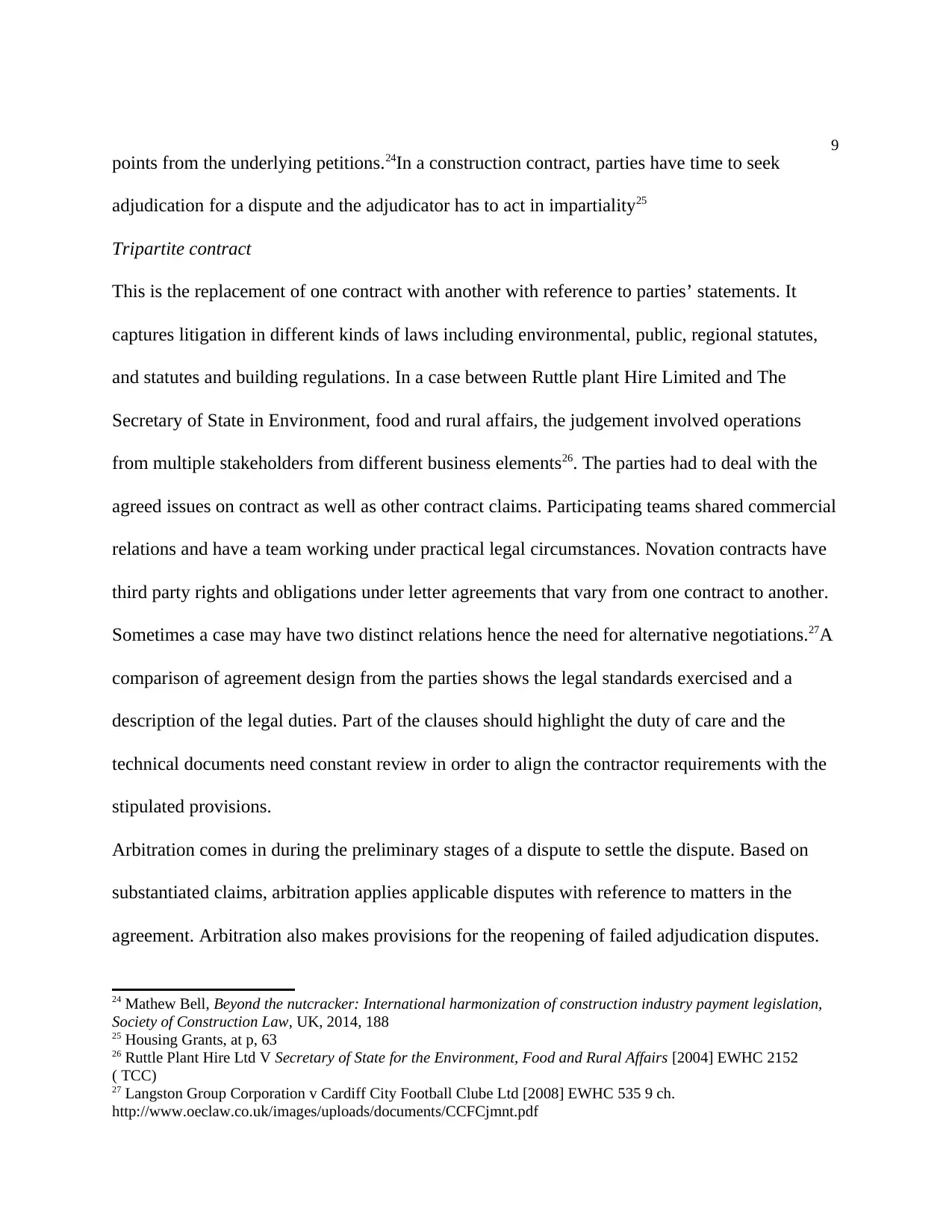
9
points from the underlying petitions.24In a construction contract, parties have time to seek
adjudication for a dispute and the adjudicator has to act in impartiality25
Tripartite contract
This is the replacement of one contract with another with reference to parties’ statements. It
captures litigation in different kinds of laws including environmental, public, regional statutes,
and statutes and building regulations. In a case between Ruttle plant Hire Limited and The
Secretary of State in Environment, food and rural affairs, the judgement involved operations
from multiple stakeholders from different business elements26. The parties had to deal with the
agreed issues on contract as well as other contract claims. Participating teams shared commercial
relations and have a team working under practical legal circumstances. Novation contracts have
third party rights and obligations under letter agreements that vary from one contract to another.
Sometimes a case may have two distinct relations hence the need for alternative negotiations.27A
comparison of agreement design from the parties shows the legal standards exercised and a
description of the legal duties. Part of the clauses should highlight the duty of care and the
technical documents need constant review in order to align the contractor requirements with the
stipulated provisions.
Arbitration comes in during the preliminary stages of a dispute to settle the dispute. Based on
substantiated claims, arbitration applies applicable disputes with reference to matters in the
agreement. Arbitration also makes provisions for the reopening of failed adjudication disputes.
24 Mathew Bell, Beyond the nutcracker: International harmonization of construction industry payment legislation,
Society of Construction Law, UK, 2014, 188
25 Housing Grants, at p, 63
26 Ruttle Plant Hire Ltd V Secretary of State for the Environment, Food and Rural Affairs [2004] EWHC 2152
( TCC)
27 Langston Group Corporation v Cardiff City Football Clube Ltd [2008] EWHC 535 9 ch.
http://www.oeclaw.co.uk/images/uploads/documents/CCFCjmnt.pdf
points from the underlying petitions.24In a construction contract, parties have time to seek
adjudication for a dispute and the adjudicator has to act in impartiality25
Tripartite contract
This is the replacement of one contract with another with reference to parties’ statements. It
captures litigation in different kinds of laws including environmental, public, regional statutes,
and statutes and building regulations. In a case between Ruttle plant Hire Limited and The
Secretary of State in Environment, food and rural affairs, the judgement involved operations
from multiple stakeholders from different business elements26. The parties had to deal with the
agreed issues on contract as well as other contract claims. Participating teams shared commercial
relations and have a team working under practical legal circumstances. Novation contracts have
third party rights and obligations under letter agreements that vary from one contract to another.
Sometimes a case may have two distinct relations hence the need for alternative negotiations.27A
comparison of agreement design from the parties shows the legal standards exercised and a
description of the legal duties. Part of the clauses should highlight the duty of care and the
technical documents need constant review in order to align the contractor requirements with the
stipulated provisions.
Arbitration comes in during the preliminary stages of a dispute to settle the dispute. Based on
substantiated claims, arbitration applies applicable disputes with reference to matters in the
agreement. Arbitration also makes provisions for the reopening of failed adjudication disputes.
24 Mathew Bell, Beyond the nutcracker: International harmonization of construction industry payment legislation,
Society of Construction Law, UK, 2014, 188
25 Housing Grants, at p, 63
26 Ruttle Plant Hire Ltd V Secretary of State for the Environment, Food and Rural Affairs [2004] EWHC 2152
( TCC)
27 Langston Group Corporation v Cardiff City Football Clube Ltd [2008] EWHC 535 9 ch.
http://www.oeclaw.co.uk/images/uploads/documents/CCFCjmnt.pdf
⊘ This is a preview!⊘
Do you want full access?
Subscribe today to unlock all pages.

Trusted by 1+ million students worldwide
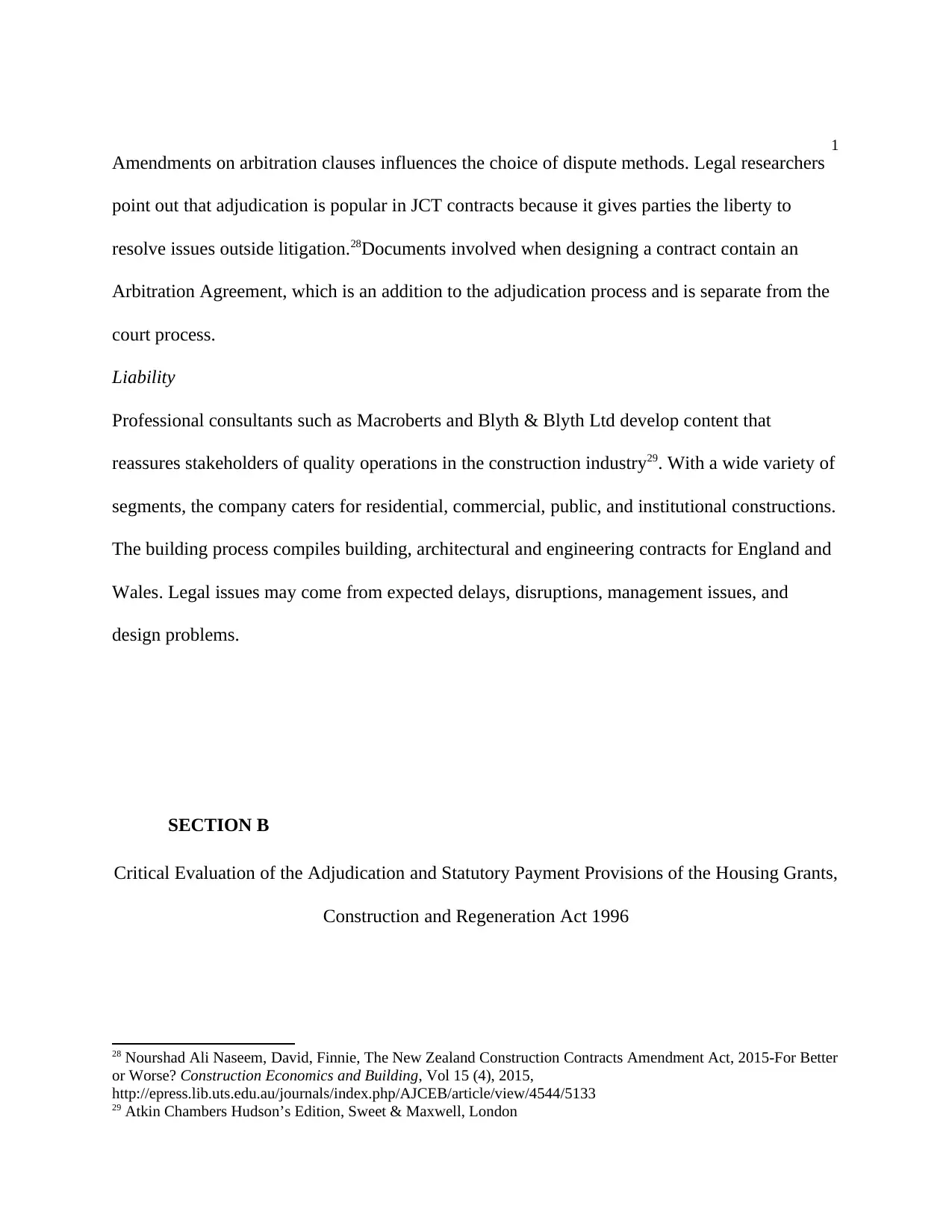
1
0Amendments on arbitration clauses influences the choice of dispute methods. Legal researchers
point out that adjudication is popular in JCT contracts because it gives parties the liberty to
resolve issues outside litigation.28Documents involved when designing a contract contain an
Arbitration Agreement, which is an addition to the adjudication process and is separate from the
court process.
Liability
Professional consultants such as Macroberts and Blyth & Blyth Ltd develop content that
reassures stakeholders of quality operations in the construction industry29. With a wide variety of
segments, the company caters for residential, commercial, public, and institutional constructions.
The building process compiles building, architectural and engineering contracts for England and
Wales. Legal issues may come from expected delays, disruptions, management issues, and
design problems.
SECTION B
Critical Evaluation of the Adjudication and Statutory Payment Provisions of the Housing Grants,
Construction and Regeneration Act 1996
28 Nourshad Ali Naseem, David, Finnie, The New Zealand Construction Contracts Amendment Act, 2015-For Better
or Worse? Construction Economics and Building, Vol 15 (4), 2015,
http://epress.lib.uts.edu.au/journals/index.php/AJCEB/article/view/4544/5133
29 Atkin Chambers Hudson’s Edition, Sweet & Maxwell, London
0Amendments on arbitration clauses influences the choice of dispute methods. Legal researchers
point out that adjudication is popular in JCT contracts because it gives parties the liberty to
resolve issues outside litigation.28Documents involved when designing a contract contain an
Arbitration Agreement, which is an addition to the adjudication process and is separate from the
court process.
Liability
Professional consultants such as Macroberts and Blyth & Blyth Ltd develop content that
reassures stakeholders of quality operations in the construction industry29. With a wide variety of
segments, the company caters for residential, commercial, public, and institutional constructions.
The building process compiles building, architectural and engineering contracts for England and
Wales. Legal issues may come from expected delays, disruptions, management issues, and
design problems.
SECTION B
Critical Evaluation of the Adjudication and Statutory Payment Provisions of the Housing Grants,
Construction and Regeneration Act 1996
28 Nourshad Ali Naseem, David, Finnie, The New Zealand Construction Contracts Amendment Act, 2015-For Better
or Worse? Construction Economics and Building, Vol 15 (4), 2015,
http://epress.lib.uts.edu.au/journals/index.php/AJCEB/article/view/4544/5133
29 Atkin Chambers Hudson’s Edition, Sweet & Maxwell, London
Paraphrase This Document
Need a fresh take? Get an instant paraphrase of this document with our AI Paraphraser
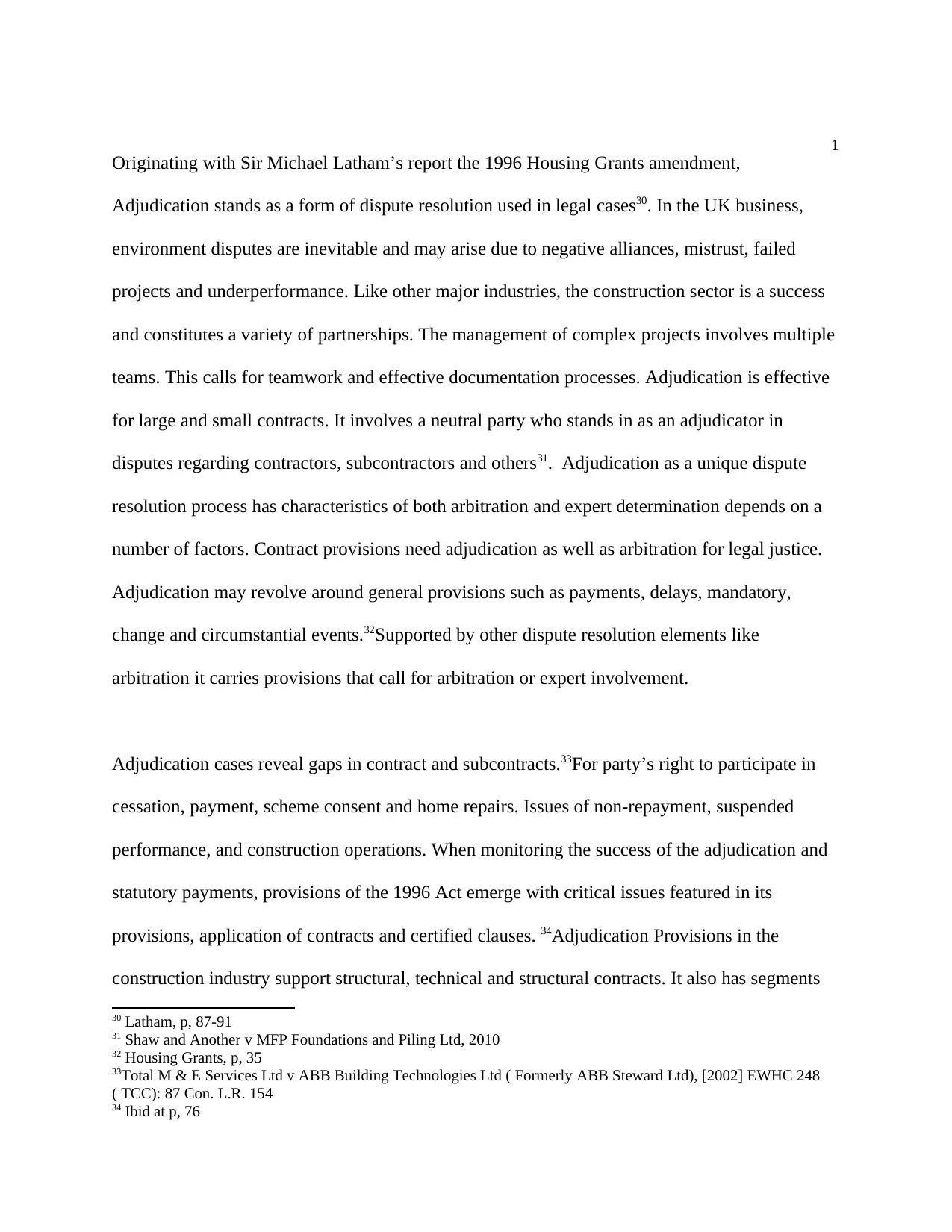
1
1Originating with Sir Michael Latham’s report the 1996 Housing Grants amendment,
Adjudication stands as a form of dispute resolution used in legal cases30. In the UK business,
environment disputes are inevitable and may arise due to negative alliances, mistrust, failed
projects and underperformance. Like other major industries, the construction sector is a success
and constitutes a variety of partnerships. The management of complex projects involves multiple
teams. This calls for teamwork and effective documentation processes. Adjudication is effective
for large and small contracts. It involves a neutral party who stands in as an adjudicator in
disputes regarding contractors, subcontractors and others31. Adjudication as a unique dispute
resolution process has characteristics of both arbitration and expert determination depends on a
number of factors. Contract provisions need adjudication as well as arbitration for legal justice.
Adjudication may revolve around general provisions such as payments, delays, mandatory,
change and circumstantial events.32Supported by other dispute resolution elements like
arbitration it carries provisions that call for arbitration or expert involvement.
Adjudication cases reveal gaps in contract and subcontracts.33For party’s right to participate in
cessation, payment, scheme consent and home repairs. Issues of non-repayment, suspended
performance, and construction operations. When monitoring the success of the adjudication and
statutory payments, provisions of the 1996 Act emerge with critical issues featured in its
provisions, application of contracts and certified clauses. 34Adjudication Provisions in the
construction industry support structural, technical and structural contracts. It also has segments
30 Latham, p, 87-91
31 Shaw and Another v MFP Foundations and Piling Ltd, 2010
32 Housing Grants, p, 35
33Total M & E Services Ltd v ABB Building Technologies Ltd ( Formerly ABB Steward Ltd), [2002] EWHC 248
( TCC): 87 Con. L.R. 154
34 Ibid at p, 76
1Originating with Sir Michael Latham’s report the 1996 Housing Grants amendment,
Adjudication stands as a form of dispute resolution used in legal cases30. In the UK business,
environment disputes are inevitable and may arise due to negative alliances, mistrust, failed
projects and underperformance. Like other major industries, the construction sector is a success
and constitutes a variety of partnerships. The management of complex projects involves multiple
teams. This calls for teamwork and effective documentation processes. Adjudication is effective
for large and small contracts. It involves a neutral party who stands in as an adjudicator in
disputes regarding contractors, subcontractors and others31. Adjudication as a unique dispute
resolution process has characteristics of both arbitration and expert determination depends on a
number of factors. Contract provisions need adjudication as well as arbitration for legal justice.
Adjudication may revolve around general provisions such as payments, delays, mandatory,
change and circumstantial events.32Supported by other dispute resolution elements like
arbitration it carries provisions that call for arbitration or expert involvement.
Adjudication cases reveal gaps in contract and subcontracts.33For party’s right to participate in
cessation, payment, scheme consent and home repairs. Issues of non-repayment, suspended
performance, and construction operations. When monitoring the success of the adjudication and
statutory payments, provisions of the 1996 Act emerge with critical issues featured in its
provisions, application of contracts and certified clauses. 34Adjudication Provisions in the
construction industry support structural, technical and structural contracts. It also has segments
30 Latham, p, 87-91
31 Shaw and Another v MFP Foundations and Piling Ltd, 2010
32 Housing Grants, p, 35
33Total M & E Services Ltd v ABB Building Technologies Ltd ( Formerly ABB Steward Ltd), [2002] EWHC 248
( TCC): 87 Con. L.R. 154
34 Ibid at p, 76
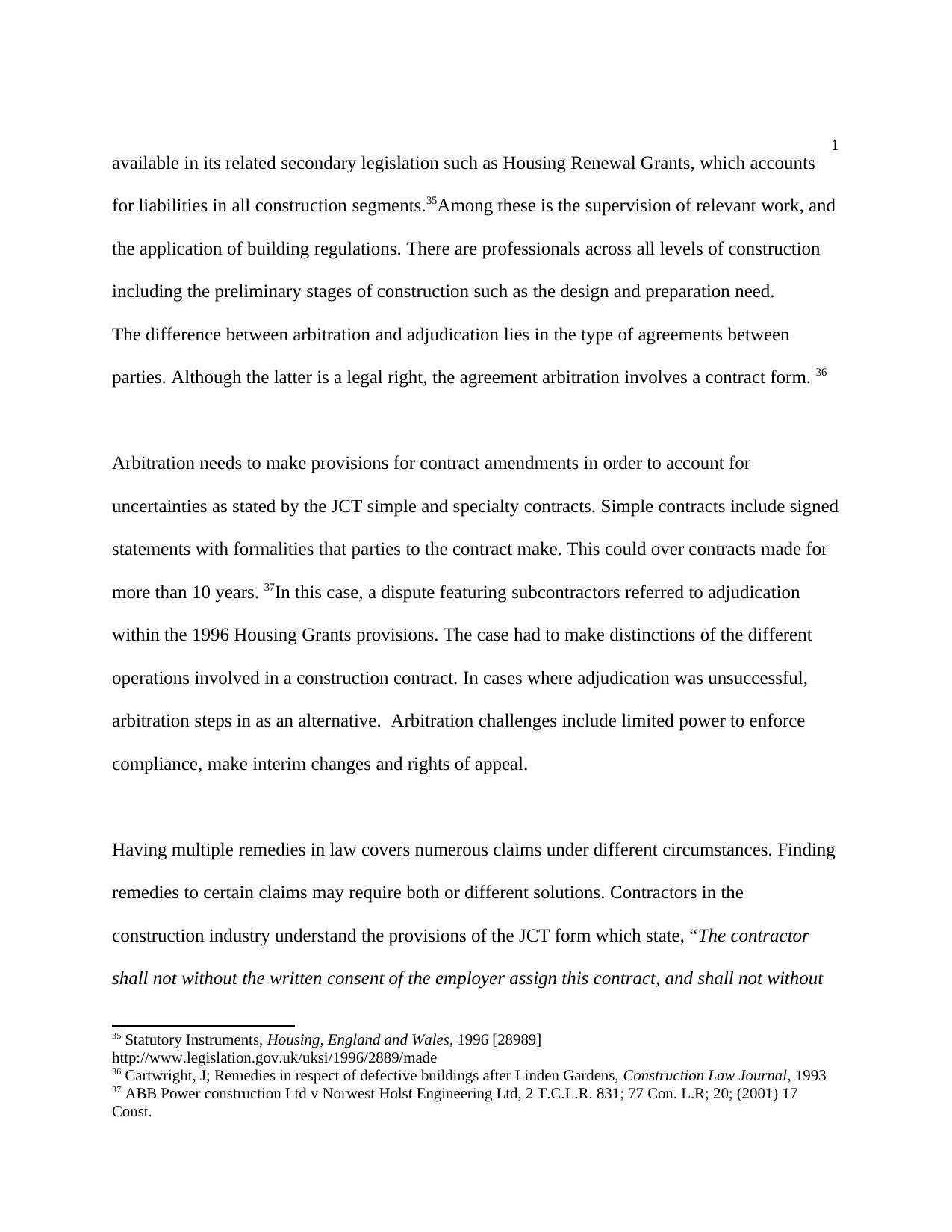
1
2available in its related secondary legislation such as Housing Renewal Grants, which accounts
for liabilities in all construction segments.35Among these is the supervision of relevant work, and
the application of building regulations. There are professionals across all levels of construction
including the preliminary stages of construction such as the design and preparation need.
The difference between arbitration and adjudication lies in the type of agreements between
parties. Although the latter is a legal right, the agreement arbitration involves a contract form. 36
Arbitration needs to make provisions for contract amendments in order to account for
uncertainties as stated by the JCT simple and specialty contracts. Simple contracts include signed
statements with formalities that parties to the contract make. This could over contracts made for
more than 10 years. 37In this case, a dispute featuring subcontractors referred to adjudication
within the 1996 Housing Grants provisions. The case had to make distinctions of the different
operations involved in a construction contract. In cases where adjudication was unsuccessful,
arbitration steps in as an alternative. Arbitration challenges include limited power to enforce
compliance, make interim changes and rights of appeal.
Having multiple remedies in law covers numerous claims under different circumstances. Finding
remedies to certain claims may require both or different solutions. Contractors in the
construction industry understand the provisions of the JCT form which state, “The contractor
shall not without the written consent of the employer assign this contract, and shall not without
35 Statutory Instruments, Housing, England and Wales, 1996 [28989]
http://www.legislation.gov.uk/uksi/1996/2889/made
36 Cartwright, J; Remedies in respect of defective buildings after Linden Gardens, Construction Law Journal, 1993
37 ABB Power construction Ltd v Norwest Holst Engineering Ltd, 2 T.C.L.R. 831; 77 Con. L.R; 20; (2001) 17
Const.
2available in its related secondary legislation such as Housing Renewal Grants, which accounts
for liabilities in all construction segments.35Among these is the supervision of relevant work, and
the application of building regulations. There are professionals across all levels of construction
including the preliminary stages of construction such as the design and preparation need.
The difference between arbitration and adjudication lies in the type of agreements between
parties. Although the latter is a legal right, the agreement arbitration involves a contract form. 36
Arbitration needs to make provisions for contract amendments in order to account for
uncertainties as stated by the JCT simple and specialty contracts. Simple contracts include signed
statements with formalities that parties to the contract make. This could over contracts made for
more than 10 years. 37In this case, a dispute featuring subcontractors referred to adjudication
within the 1996 Housing Grants provisions. The case had to make distinctions of the different
operations involved in a construction contract. In cases where adjudication was unsuccessful,
arbitration steps in as an alternative. Arbitration challenges include limited power to enforce
compliance, make interim changes and rights of appeal.
Having multiple remedies in law covers numerous claims under different circumstances. Finding
remedies to certain claims may require both or different solutions. Contractors in the
construction industry understand the provisions of the JCT form which state, “The contractor
shall not without the written consent of the employer assign this contract, and shall not without
35 Statutory Instruments, Housing, England and Wales, 1996 [28989]
http://www.legislation.gov.uk/uksi/1996/2889/made
36 Cartwright, J; Remedies in respect of defective buildings after Linden Gardens, Construction Law Journal, 1993
37 ABB Power construction Ltd v Norwest Holst Engineering Ltd, 2 T.C.L.R. 831; 77 Con. L.R; 20; (2001) 17
Const.
⊘ This is a preview!⊘
Do you want full access?
Subscribe today to unlock all pages.

Trusted by 1+ million students worldwide
1 out of 20
Your All-in-One AI-Powered Toolkit for Academic Success.
+13062052269
info@desklib.com
Available 24*7 on WhatsApp / Email
![[object Object]](/_next/static/media/star-bottom.7253800d.svg)
Unlock your academic potential
Copyright © 2020–2025 A2Z Services. All Rights Reserved. Developed and managed by ZUCOL.

